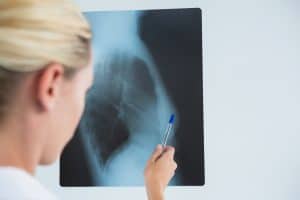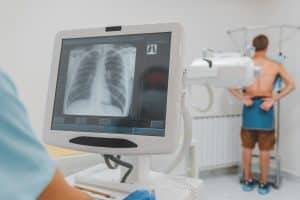FLUOROSCOPY is a study of moving body structures that is similar to an X-RAY “Movie”. It’s a type of imaging procedure that uses various pulses of an X-ray beam to take real-time footage of tissues within your body. This is a medical procedure that makes a real-time video of the movements within a part of the body, by passing X-RAYS through the body.
Health problems such as heart disease or intestinal disease can be easily detected by this medical procedure of fluoroscopy. It also guides you on how to treat “orthopedic surgery” such as “implants” or “injections”. It also helps health professionals to look inside body organs, bones, joints, and muscles.
Fluoroscopy
It is commonly used to detect how the stomach and intestines are working. It is used to check how the muscles of the mouth and throat are working and whether the food is properly swallowed or not.
Two Major Purposes
Health professionals use fluoroscopy mainly for two reasons.
- To help guide certain treatment procedures like surgeries.
- For diagnostic purposes.
Various Body Systems
Professionals can use fluoroscopy to observe the variety of body systems in real-time, which are as follow:
- Urinary system
- Digestive system
- Cardiovascular system
- Reproductive system
- Musculoskeletal system
Introduction
Fluoroscopy is a medical imaging technique that engages continuous X-rays to produce real-time images of internal structures within the body. It offers vital visualization of organs, tissues, and other body systems, making it a valuable tool for diagnosis. In this article, we will consider the principles of fluoroscopy, its applications, and the necessary preparations to ensure a safe and effective procedure.
Understanding Fluoroscopy
Fluoroscopy is a specialized form of X-ray imaging that enables physicians to view moving images of the body in real time. Unlike ordinary X-rays that capture static images, medical procedure fluoroscopy provides dynamic images, making it extremely useful for observing the movements and functions of various body systems.
The fluoroscopy procedure involves the use of a fluoroscope, which is an instrument mainly used in medical diagnosis to observe the internal structure. The fluoroscope consists of an X-ray source and a fluorescent screen and a patient is placed in between them. Most fluoroscope includes X-RAY image intensifiers and cameras too, to improve the image visibility. Fluoroscopy is similar to radiography.
Applications of Fluoroscopy
Diagnostic Imaging: Fluoroscopy is commonly used to examine the gastrointestinal (GI) tract, including the esophagus, stomach, and intestines. Barium contrast agents are often ingested or administered rectally to highlight the GI tract on the fluoroscopy images, allowing physicians to detect abnormalities such as ulcers, tumors, and strictures. Moreover, fluoroscopy aids in evaluating the movement and function of organs.
Angiography
It uses fluoroscopy to identify and diagnose blockages in the arteries in your body.
Cystography
It is an imaging test in which fluoroscopy can be used to help diagnose problems in your bladder.
Myelography
It uses fluoroscopy to examine your spinal cord. It is significantly useful in examining your spine and for assessing disc problems as well.
Hysterosalpingogram
This procedure is used by health providers to facilitate images of female reproductive organs and is also helpful in detecting various causes of infertility.
Interventional Procedures: Fluoroscopy plays a crucial role in guiding various medical procedures, such as angiography, cardiac catheterization, and joint injections. By providing real-time images during the procedure, physicians can precisely navigate catheters and instruments to the target area, increasing the procedure’s accuracy and safety.
Orthopedics
Fluoroscopy is employed in orthopedics to visualize and guide the reduction of fractures and treatment of fractures.
Urology
In urological procedures, fluoroscopy is used to guide the placement of devices such as stents.
Pain Management
Fluoroscopy is utilized in pain management procedures, including nerve blocks and epidural steroid injections.
Preparation for Fluoroscopy
Preparations for fluoroscopy vary from patient to patient as it depends on one’s health condition. Many X-ray and fluoroscopy procedures of chest and bones do not require any preparations.
Pre-Procedure Instructions
Before undergoing a fluoroscopy procedure, patients will receive specific instructions from their healthcare provider. These instructions may include dietary restrictions and fasting. For gastrointestinal fluoroscopy, patients may need to keep their stomachs empty for satisfactory exams to ensure a clear visualization of the GI tract.
Informed Consent
Patients need to give informed consent before undergoing fluoroscopy. The healthcare provider will explain the whole procedure, its purpose, potential risks, and benefits to the patient. Patients should have the opportunity to ask questions and clarify all their concerns.
Medical History and Allergies
Patients should inform their healthcare providers about any medical conditions they have, such as heart disease, kidney problems, or pregnancy, as these factors can influence the decision to undergo. Additionally, patients should disclose any known allergies.
Pregnancy and Breastfeeding
Fluoroscopy involves the use of X-rays, which can be strongly harmful to a developing fetus. Therefore, female patients must inform their healthcare providers if they are pregnant.
Dressing and Metal Objects
Patients will typically be asked to change into a hospital gown before the procedure. It is essential to remove all metal objects, such as jewelry.
Conclusion
Fluoroscopy is a valuable medical imaging technique that allows for real-time visualization of internal structures within the body. Its dynamic imaging capabilities make it essential for diagnosing various medical conditions and guiding interventions. Understanding the theory of fluoroscopy and appropriately preparation for Fluoroscopy procedure, ensures patients its effectiveness.





